Ngorongoro National Park
Ngorongoro National Park: Tanzania’s Pristine Wilderness
Ngorongoro National Park; one of Tanzania’s most remarkable natural wonders. Nestled within the larger Ngorongoro Conservation Area, this park is home to the world-renowned Ngorongoro Crater, often referred to as the “Eighth Wonder of the World.” With its rich biodiversity, dramatic landscapes, and deep cultural significance, Ngorongoro National Park offers a unique blend of wildlife experiences and cultural encounters. This article delves into the fascinating aspects of Ngorongoro, providing insights into what makes this park a must-visit destination for nature lovers and adventure seekers alike.
Why Visit Ngorongoro National Park?
Ngorongoro National Park is a destination that offers something for everyone:
- Ngorongoro Crater: The largest inactive and intact volcanic caldera in the world, providing a haven for wildlife.
- Rich Biodiversity: Home to over 25,000 large animals, including the Big Five, as well as a variety of bird species.
- Cultural Significance: The park is located within the Ngorongoro Conservation Area, a UNESCO World Heritage Site that is also home to the Maasai people.
Ngorongoro Crater: A Geological Marvel
The centerpiece of Ngorongoro National Park is the Ngorongoro Crater, a massive volcanic caldera that offers stunning views and exceptional wildlife experiences.
1. Formation of the Crater
- Volcanic Origins: The crater was formed millions of years ago when a giant volcano erupted and collapsed on itself.
- Largest Caldera: Spanning about 260 square kilometers with a depth of over 600 meters, it is the largest intact caldera in the world.
2. Wildlife in the Crater
- Diverse Ecosystem: The crater’s diverse habitats—ranging from grasslands to forests—support a wide variety of animals.
- Big Five: The crater is one of the few places in Tanzania where you can spot the Big Five (lion, leopard, elephant, buffalo, and rhinoceros) in a single day.
Unique Wildlife Encounters
Ngorongoro National Park is a wildlife haven, offering some of the best game viewing opportunities in Tanzania.
1. Predator Paradise
- Lions: The crater is home to one of the densest lion populations in Africa, offering excellent sightings.
- Leopards: Though elusive, leopards can be spotted in the forested areas around the crater rim.
- Hyenas: Large packs of hyenas are often seen roaming the crater floor, scavenging and hunting in packs.
2. Herbivore Heaven
- Elephants: The park’s lush forests are a sanctuary for elephants, particularly older bulls.
- Buffalo: Large herds of buffalo graze the crater floor, often accompanied by birds like oxpeckers.
- Rhinoceros: The Ngorongoro Crater is one of the last places in Tanzania where you can see the endangered black rhinoceros.
3. Birdwatching Bliss
- Flamingos: The seasonal lakes within the crater, such as Lake Magadi, attract large flocks of flamingos.
- Bird Diversity: With over 500 bird species recorded, including the rare kori bustard, Ngorongoro is a birdwatcher’s paradise.
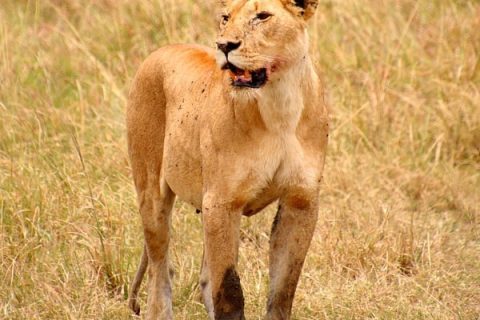
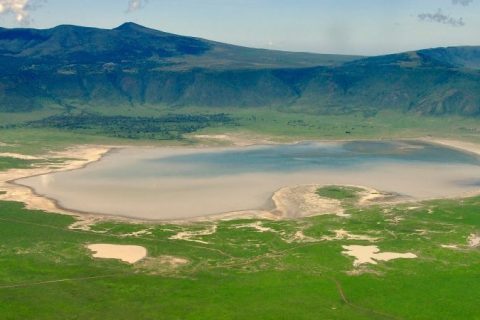
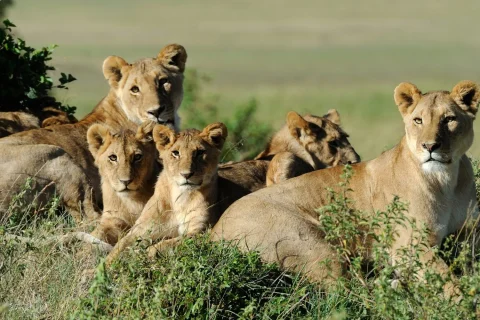
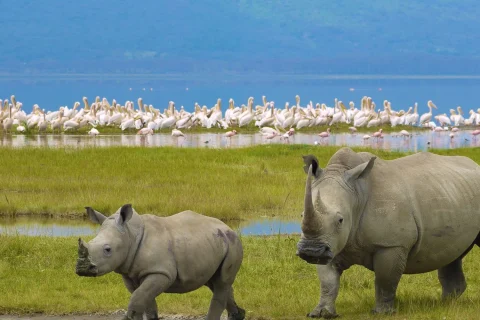
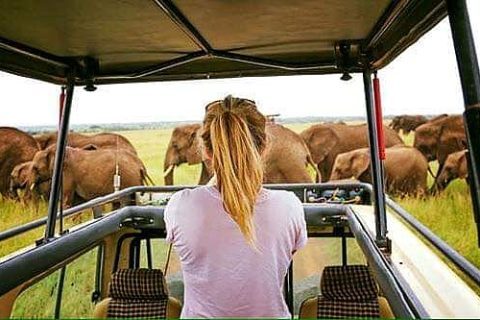
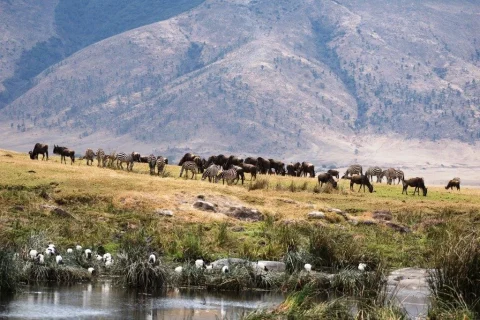
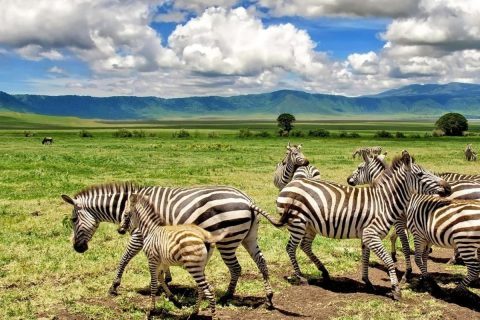
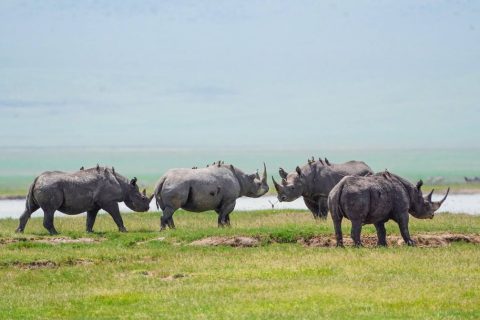
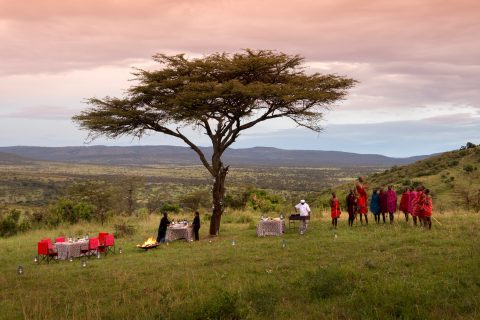

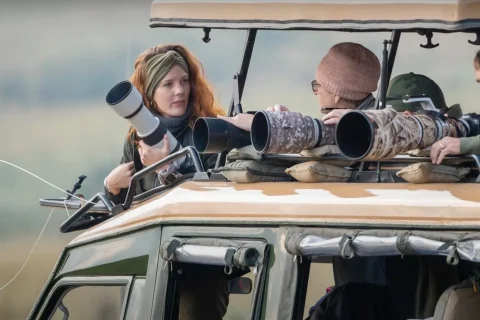
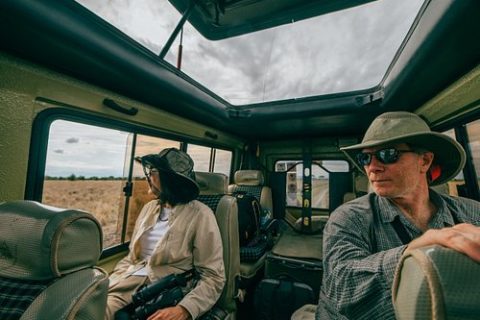
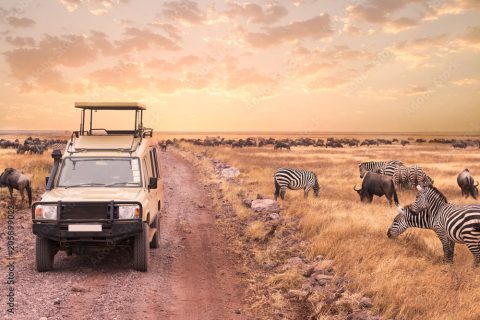
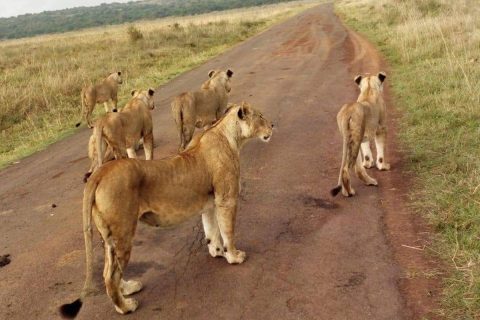
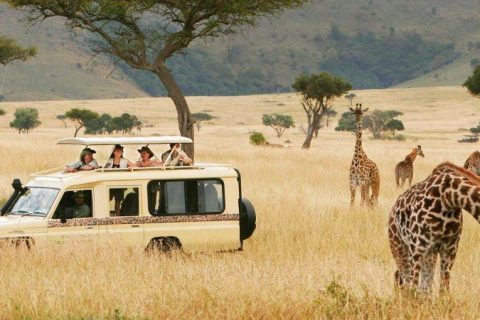
Tourism in Ngorongoro National Park
Exploring Ngorongoro’s Diverse Landscapes
Beyond the crater, Ngorongoro National Park offers a variety of landscapes that contribute to its rich biodiversity.
1. Lerai Forest
- Lush Habitat: This dense forest on the crater floor is a prime spot for elephant and leopard sightings.
- Birdlife: The forest is also home to a variety of bird species, making it a favorite among birdwatchers.
2. Gorigor Swamp
- Vital Water Source: The swamp is an important water source for animals, particularly during the dry season.
- Hippos: The swamp is a popular spot for hippos, which can often be seen wallowing in the mud.
3. Olmoti and Empakaai Craters
- Hiking Opportunities: These smaller craters, located north of the Ngorongoro Crater, offer excellent hiking opportunities with spectacular views.
- Flamingos at Empakaai: Empakaai Crater’s lake is a magnet for flamingos, creating a picturesque scene.
Activities and Experiences in Ngorongoro
Ngorongoro National Park offers a range of activities that cater to different interests and provide unique ways to explore the park.
1. Game Drives
- Crater Floor Safaris: Game drives on the crater floor offer close-up encounters with a variety of wildlife, including the Big Five.
- Guided Tours: Knowledgeable guides enhance the experience with insights into the park’s ecology and wildlife behavior.
2. Walking Safaris
- Crater Rim Walks: Walking along the crater rim offers breathtaking views and the chance to explore the park’s flora and fauna on foot.
- Guided Hikes: Walking safaris are led by experienced guides who ensure a safe and informative experience.
3. Cultural Experiences
- Maasai Villages: Visit a Maasai village to learn about the traditional lifestyle and customs of the Maasai people.
- Cultural Heritage: The Maasai have coexisted with the wildlife in this region for centuries, offering a unique cultural perspective.
4. Photographic Safaris
- Photogenic Landscapes: The dramatic landscapes and abundant wildlife make Ngorongoro a photographer’s dream.
- Professional Guidance: Photographic safaris led by professional photographers are available for those looking to capture the perfect shot.
Tanzania Tour Packages
1 Day Mount Kilimanjaro Hiking Adventure
The majestic Mount Kilimanjaro is Tanzania’s most famous landmark, but…
6 Days Best Adventure Kilimanjaro, Tarangire, Serengeti & Ngorongoro Tour
This Tanzanian safari is the greatest safari tour to a…
1 Day Trip to Tarangire National Park
This day journey from Arusha to Tarangire National Park is…
1 Day Classic Balloon Safari in Serengeti & Tarangire with Breakfast
Take an amazing hot air balloon flight over the Serengeti…
1 Day Safari Blue Zanzibar Adventure
This full-day group tour allows you to easily observe the…
1 Day Trip to Ngorongoro Crater
While there are other safari parks in Africa, none compared…
4 Days Join Group Tarangire, Serengeti & Ngorongoro Crater
With hassle-free round-trip transportation from your hotel or airport, this…
4 Days Mikumi & Udzungwa National Parks Safari
On this unforgettable safari adventure, discover the best of eastern…
3 Days Small Group Safari to Serengeti & Ngorongoro Crater in Tanzania
On this 3-day safari departing from Arusha, combine a visit…
2 Days Safari to Mikumi from Zanzibar
Take a two-day safari to Mikumi National Park to escape…
1 Day Safari Tour to Selous National Park, Flying from Zanzibar
When you reserve this full-day, private tour with flights, you’ll…
5 Days Camping Tarangire, Serengeti, Ngorongoro & Maasai Visit
Take a 5-day camping safari that starts in Arusha and…
1 Day from Zanzibar to Mikumi Safari including Flights
Come along with us for an amazing safari from Zanzibar…
4 Days Tanzania’s National Parks Tour
Take this 4-day safari tour to see as many of…
Best Time to Visit Ngorongoro National Park
The best time to visit Ngorongoro National Park depends on your interests and what you want to experience.
1. Dry Season (June to October)
- Optimal Wildlife Viewing: The dry season offers the best conditions for game viewing, as animals congregate around water sources.
- Pleasant Weather: The weather is cooler and less humid, making it ideal for outdoor activities.
2. Wet Season (November to May)
- Lush Landscapes: The park is at its most beautiful during the wet season, with green landscapes and blooming flowers.
- Birdwatching: Migratory birds arrive during the wet season, adding to the park’s already impressive birdlife.
Sustainable Tourism in Ngorongoro
Ngorongoro National Park is committed to sustainable tourism practices that protect its unique ecosystems and support local communities.
1. Conservation Efforts
- Anti-Poaching Measures: The park has implemented strict anti-poaching measures to protect its wildlife, particularly the endangered black rhinoceros.
- Community Involvement: Local communities are actively involved in conservation efforts, helping to ensure the park’s long-term sustainability.
2. Eco-Friendly Accommodations
- Sustainable Lodges: Many lodges in the park are designed to minimize their environmental impact, using solar power and sustainable materials.
- Supporting Local Communities: These accommodations often support local communities by providing jobs and funding for education and healthcare initiatives.
Ngorongoro National Park is a destination that offers an unparalleled blend of natural beauty, wildlife encounters, and cultural experiences. Whether you’re exploring the crater’s rich ecosystems, encountering the Maasai people, or simply soaking in the breathtaking views, Ngorongoro promises an unforgettable adventure. As a place of both ecological and cultural significance, it stands as a testament to the harmony that can exist between humans and nature.
